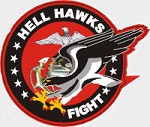Legion LEG14619LF USMC Chance-Vought F4U-1 Corsair Fighter - "Daphne 'C'," 2nd Lieutenant James N. Cupp, VMF-213 "Hell Hawks," Guadalcanal, Solomon Islands, July 1943 (1:72 Scale)
"Why should we have a navy at all? There are no enemies for it to fight except apparently the Army Air Force."
- General Carl Spaatz, Commander of the US 8th Army Air Force, after WWII
 The Vought F4U Corsair is an American fighter aircraft which saw service primarily in World War II and the Korean War. Designed and initially manufactured by Chance Vought, the Corsair was soon in great demand; additional production contracts were given to Goodyear, whose Corsairs were designated FG, and Brewster, designated F3A.
The Vought F4U Corsair is an American fighter aircraft which saw service primarily in World War II and the Korean War. Designed and initially manufactured by Chance Vought, the Corsair was soon in great demand; additional production contracts were given to Goodyear, whose Corsairs were designated FG, and Brewster, designated F3A.
The Corsair was designed and operated as a carrier-based aircraft, and entered service in large numbers with the U.S. Navy in late 1944 and early 1945. It quickly became one of the most capable carrier-based fighter-bombers of World War II. Some Japanese pilots regarded it as the most formidable American fighter of World War II and its naval aviators achieved an 11:1 kill ratio. Early problems with carrier landings and logistics led to it being eclipsed as the dominant carrier-based fighter by the Grumman F6F Hellcat, powered by the same Double Wasp engine first flown on the Corsair's initial prototype in 1940. Instead, the Corsair's early deployment was to land-based squadrons of the U.S. Marine Corps and U.S. Navy.
The Corsair served almost exclusively as a fighter-bomber throughout the Korean War and during the French colonial wars in Indochina and Algeria. In addition to its use by the U.S. and British, the Corsair was also used by the Royal New Zealand Air Force, French Naval Aviation, and other air forces until the 1960s.
From the first prototype delivery to the U.S. Navy in 1940, to final delivery in 1953 to the French, 12,571 F4U Corsairs were manufactured in 16 separate models. Its 1942-1953 production run was the longest of any U.S. piston-engined fighter.
Pictured here is a 1:72 scale replica of a US Navy Chance-Vought F4U-1 Corsair fighter that was piloted by 2nd Lieutenant James N. Cupp, who was attached to VMF-213 "Hell Hawks," then deployed to Guadalcanal, in the Solomon Islands, during July 1943.
Now in stock!
Dimensions:
Wingspan: 7-inches
Length: 6-inches
Release Date: November 2024
 Historical Account: "Daphne 'C'" - James Cupp enlisted in the Navy on May 15th, 1941, and entered the V-5 flight training program. He graduated at Naval Air Station Corpus Christi, Texas January 9th, 1942, and was commissioned a second lieutenant in the United States Marine Corps, February 27th, 1942. On March 3rd, 1942, he married Daphne Snider, of Fairfield, Iowa. Cupp then attended aerial photography training at Naval Air Station Pensacola, Florida.
Historical Account: "Daphne 'C'" - James Cupp enlisted in the Navy on May 15th, 1941, and entered the V-5 flight training program. He graduated at Naval Air Station Corpus Christi, Texas January 9th, 1942, and was commissioned a second lieutenant in the United States Marine Corps, February 27th, 1942. On March 3rd, 1942, he married Daphne Snider, of Fairfield, Iowa. Cupp then attended aerial photography training at Naval Air Station Pensacola, Florida.
Cupp was attached to VMF-213, the Hell Hawks, in September 1942 at Marine Corps Air Station Ewa and later flew the Vought F4U Corsair. He had his crew paint Daphne "C", for his wife, on the engine cowling of his Corsair. He arrived at the Solomon Islands for his first combat tour on April 3rd, 1943. Cupp scored his first aerial victory on July 15th, 1943, and was an ace three days later. During his tour he was credited with 13-1/2 or 13 aerial victories based on reports by his wing men. According to Guttman (2005), he was officially credited with 12 victories.
On September 20th, 1943, Captain Cupp was shot down north of Kolombangara by a G4M1 Betty with an improvised gun unexpectedly mounted in its bomb bay; he was severely burned. He spent the next 18 months in hospitals, primarily Oak Knoll Naval Hospital in Oakland, California. After that, he served as a Naval flight instructor. The war ended before he could return to the Pacific theater.


